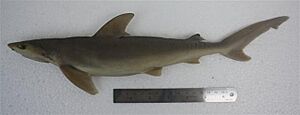Blackspot shark facts for kids
Quick facts for kids Blackspot shark |
|
|---|---|
 |
|
| Conservation status | |
| Scientific classification | |
| Genus: |
Carcharhinus
|
| Species: |
sealei
|
 |
|
| Synonyms | |
|
|
The blackspot shark (Carcharhinus sealei) is a small type of requiem shark. It lives in the warm parts of the Indo-West Pacific Ocean. You can find it from the surface down to about 40 meters (130 feet) deep. This shark is usually less than one meter (3 feet) long. It is not considered dangerous to people. Blackspot sharks mostly eat fish, crabs, and squid. People also catch these sharks for food in small fishing operations.
Contents
What Does the Blackspot Shark Look Like?
The blackspot shark has a sleek, slender body. It can grow to about 95 centimeters (37 inches) long. Its snout is quite long and pointed. The eyes are large and oval, with a special nictitating membrane that protects them. This membrane is like an eyelid on the lower side of the eye.
Shark Teeth and Gills
This shark usually has 12 rows of teeth on each side of its upper and lower jaws. The upper teeth are sharp and saw-like. The lower teeth can be smooth or saw-like. It has five gill slits, which are openings for breathing. There are no spiracles, which are small breathing holes found in some sharks.
Fins of the Blackspot Shark
The first dorsal fin (the one on its back) is long and curved. It starts right above where the pectoral fins (side fins) end. The second dorsal fin is fairly large. It starts a little behind the anal fin (the fin near the tail). The pectoral fins are long and narrow. The tail fin is about one-fifth of the shark's total length.
Shark Colors and Markings
The blackspot shark is brownish or silvery-grey on top. Its belly is pale grey. It has a faint pale stripe along its side. The most special mark is a large, black, triangle-shaped spot on its second dorsal fin. This spot covers at least half of the fin. Other fins do not have special marks, but their back edges are pale.
How to Tell It Apart from Other Sharks
The blackspot shark can sometimes be confused with the whitecheek shark (Carcharhinus dussumieri). However, the whitecheek shark has a different first dorsal fin shape. Its second dorsal fin is also smaller and only has a dark edge, not a big black spot.
Where Do Blackspot Sharks Live?
The blackspot shark lives in the Indian and Pacific Oceans. It prefers continental shelves and shallow waters around islands. It stays close to the coast, from the surf line down to about 40 meters (130 feet) deep. This shark usually avoids low-salt water, so you won't find it in river mouths.
Blackspot Shark Locations Around the World
In the Indian Ocean, you can find it along the east coast of Africa. This includes places like South Africa, Madagascar, and Kenya. It also lives around the Seychelles and Mauritius islands. Further east, it is found near Pakistan, India, and Sri Lanka. In the western Pacific Ocean, it lives along the coasts of Thailand, Vietnam, China, Indonesia, New Guinea, and northern and western Australia. In South Africa, these sharks seem to live there all year. However, their numbers might increase during the summer months.
Blackspot Shark Life Cycle and Habits
The blackspot shark eats small fish, crabs, and squid. It is not dangerous to humans. This shark grows quickly and does not live for a very long time. It becomes an adult at about one year old, when it is around 70 centimeters (28 inches) long. It can live for five years or more.
Reproduction of the Blackspot Shark
Like other sharks in its group, the blackspot shark gives birth to live young. This is called viviparous. The baby sharks grow inside the mother for about 9 months. Usually, one or two babies develop at a time. At first, the embryos get food from a yolk sac. Later, a special connection called a placenta forms to provide them with nutrients. Off the coast of Natal, South Africa, the young sharks are born in the spring.
Blackspot Shark Conservation Status
The IUCN has listed the blackspot shark as "vulnerable." This means its population is believed to be decreasing. We don't have exact numbers for how many sharks there are. However, the shallow waters where these sharks live are heavily fished.
Threats to the Blackspot Shark
Fishermen often use longlines and gillnets in these areas. This means the blackspot shark might be caught too often, which is called overfishing. The shark is sold in local markets, and its meat is eaten by people. Protecting these sharks is important to make sure they continue to thrive in the ocean.


